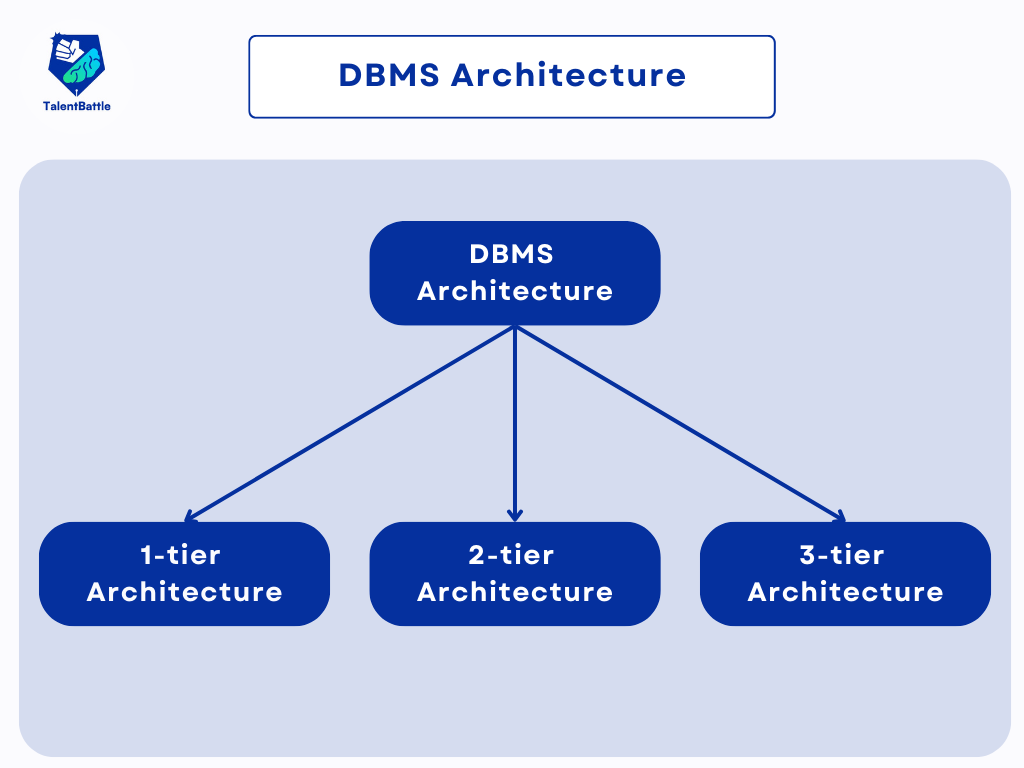Understanding DBMS Architecture
The architecture of a Database Management System (DBMS) plays a crucial role in determining how data is stored, accessed, and managed. DBMS architecture can be centralized, decentralized, or hierarchical, depending on the system's design and requirements. It can also be categorized as single-tier or multi-tier architecture, with multi-tier systems being more flexible and modular, allowing for easier updates and modifications.

Types of DBMS Architecture
Single-Tier Architecture
In a 1-tier architecture, the DBMS is the only component that the user directly interacts with. The user sits directly on the DBMS and performs tasks like designing, programming, or maintaining the database. Any changes made in the system directly affect the database. This architecture doesn't provide user-friendly tools for general users, and it is mainly used by database designers and programmers.
Though simple, single-tier architecture is limited to a technical audience because it lacks the separation between the database and the end-user, making it less suitable for non-technical users or larger systems where more flexibility is needed.
Two-Tier Architecture
In 2-tier architecture, there is an application layer that acts as a bridge between the user and the database. The user interacts with the database through the application, which manages the interactions with the database itself.
The two layers in this architecture are:
- Application Layer: Users work with an application that accesses the database. This layer is responsible for taking input from the user and interacting with the database layer.
- Database Layer: The database, along with its management and query processing functions, resides here. It processes the queries and returns the results to the application layer.
This structure is more flexible than the 1-tier model and allows for better separation between the user interface and database functions. Programmers use this architecture to develop applications that interact with the database while keeping the database design independent of the user operations.
Three-Tier Architecture
The 3-tier architecture is the most commonly used architecture in modern systems. It adds another layer between the user and the database, creating a more modular, scalable, and secure system. The three layers in this architecture are:
-
Database (Data) Tier:
- This is the lowest layer where the actual database resides. It holds all the data, tables, and relationships, along with the query processing languages that interact with the data.
- The database tier is unaware of the user or the application beyond it, focusing solely on storing and managing data.
-
Application (Middle) Tier:
- The middle tier contains the application server and the programs that access the database. It provides an abstracted view of the database to the user, meaning the user interacts only with the application and doesn't need to know how the database is structured.
- From the perspective of the database tier, the application acts as the user. This separation allows flexibility in database management, as users only see the information relevant to them.
-
User (Presentation) Tier:
- The topmost layer is the presentation layer, where the end-user interacts with the system. Users may access the data through a user-friendly interface, typically designed to hide the complexity of the underlying database and application layers.
- At this level, users can see different views of the database depending on their role or department. For example, someone in finance might see a different set of data compared to someone in human resources.
Advantages of Multi-Tier DBMS Architecture
One of the main benefits of multi-tier DBMS architecture is its modularity. Each tier functions independently, which allows developers to modify or update one layer without affecting the others. This flexibility is crucial in systems that need to evolve over time or require frequent updates.
Additionally, multi-tier architectures offer scalability. As the system grows, additional resources can be allocated to specific tiers without needing to overhaul the entire system. For instance, if the application layer needs more processing power due to increased user traffic, it can be upgraded independently of the database or user layers.
Another key advantage is security. By separating the user and database layers, sensitive data is better protected. End-users interact only with the application layer, which serves as a gatekeeper to the data. This helps in minimizing unauthorized access and providing role-based data visibility.
Conclusion
The architecture of a DBMS is a crucial factor in determining how well a system performs and how efficiently data is managed. While single-tier architectures are useful for simple, technical operations, multi-tier architectures are widely preferred due to their flexibility, scalability, and enhanced security. The 3-tier architecture, in particular, separates the user, application, and database layers, ensuring that each part functions independently while maintaining seamless interactions between them. Whether for small-scale applications or large enterprise systems, the right DBMS architecture can greatly enhance data management and user experience.




